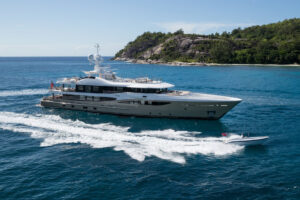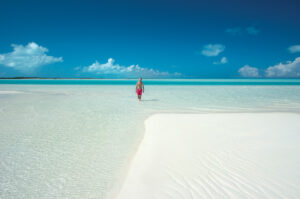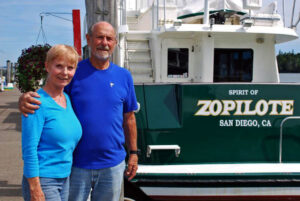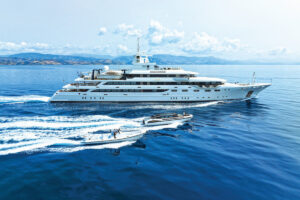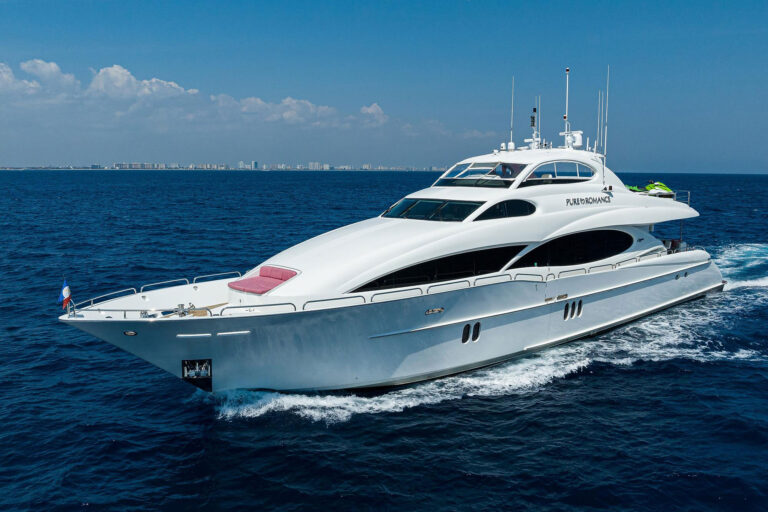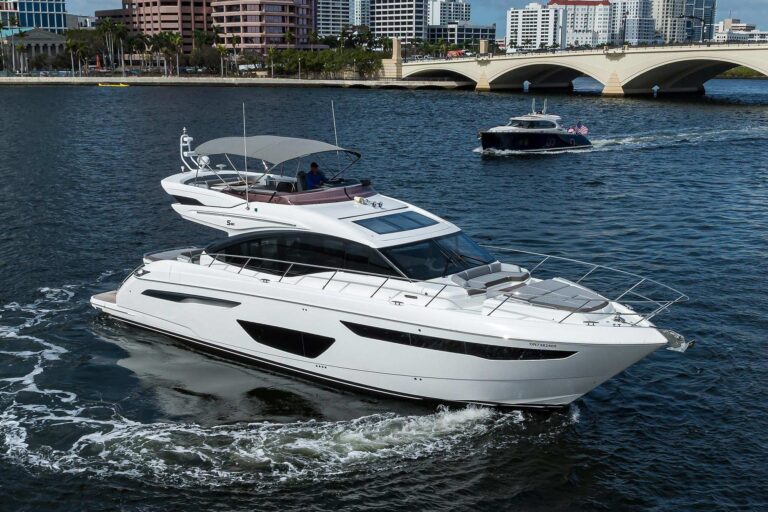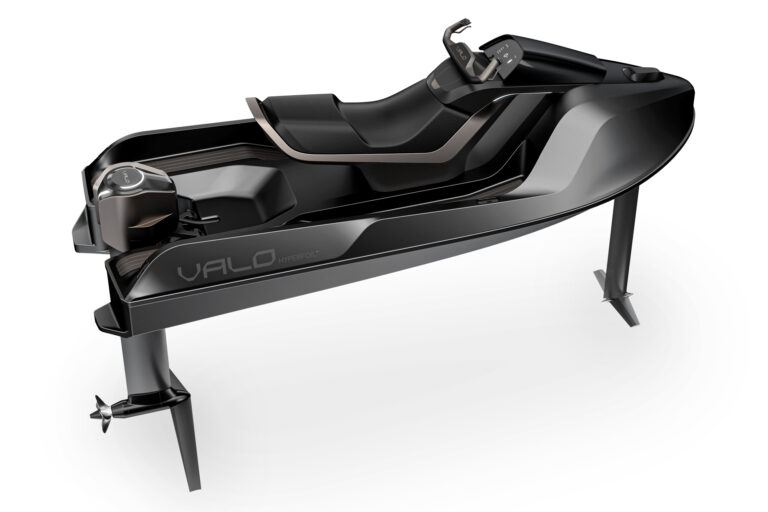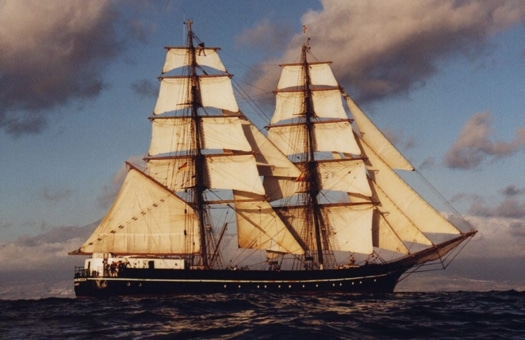
ytgjun09winner525.jpg
I served in the United States Navy for 21 years and I’ve been a recreational boater for most of my life. But in all those years, I’ve never experienced a storm like the one of March 2008, in the Irish Sea.
Since my retirement in 2005, I’ve been a volunteer crew member of the U.S. Brig Niagara out of Erie, Pennsylvania. It’s brought me into contact with several sail-training ships and their crews, who ply the waters teaching the curious about nautical history and the traditions of seamanship. Naturally, when sailors get together, there’s a lot of talk about previous adventures on other ships, and this was how I first heard about the German brig Roald Amundsen.
Roald Amundsen had seen a busy and varied life, even before our adventure. Built in 1952 as a fishing boat, she was later converted by the East German Navy into a fuel barge for use on the Baltic Sea. In 1991, Roald was rebuilt once again, but this time as a brig. While she shares the same general layout as Niagara-with two masts, a spanker, and headsails-she is built tougher, with a steel hull and masts. Much of her standing rigging is steel cable. She seemed made to handle anything, and on a journey last March from Lisbon, Portugal, to Cobh, Ireland, she was put to the test.
After hearing countless stories of Roald, I signed up to join her crew as they began their journey from the Canary Islands back to her homeport in Germany. On Valentine’s Day 2008, I flew to Tenerife in the Canary Islands to meet her. Roald’s company is drawn exclusively from a large pool of volunteer sailors-there are several hundred of them scattered around, so there’s never a lack of crew to meet the ship and sail her. On this first leg of my journey, my shipmates were exclusively German. While I had some difficulty following along in many of the conversations, my experience aboard Niagara helped me to learn the parts of the rig and understand commands.
From Tenerife to Lisbon we sailed in mostly good weather and moderate seas. Because we were making such good time, the captain stopped at Madeira for a day-a beautiful island and one I hope to visit again. The next few days of the journey passed unremarkably as I worked hard alongside my shipmates, adjusting the sails in response to changing weather.
In Lisbon, the crew from Tenerife, which had been known as Crew 216, departed for home and the next crew of 42 men and women checked aboard: Crew 217. Again, all of these crew members were from Germany, with two exceptions, a young woman from Switzerland and myself. And as is often the case with Europeans, there were more than a few who could speak conversational English. That made communications much easier, which was helpful, since almost half of this crew had never been sailing before. Before we cast off, we went through a day of training together-practicing working aloft, line-handling, standing watch, and emergency procedures.
The weather was bright and beautiful as we left Lisbon on March 3, but that afternoon it started turning against us. The wind picked up, blowing 40 to 50 knots, and the seas became much rougher. Very soon about half of our crew was seasick. The storm lasted overnight and it wasn’t until two days later that the last of our seasick cases had completely recovered.
For the next few days, as we headed north past the Iberian Peninsula, the wind and seas moderated somewhat, but the temperatures fell into the forties and stayed there. By now, everyone wore several layers of warm clothes under foul weather gear to ward off the chill. The wind stayed fairly consistent from the east and southeast and with the help of our faithful diesel engine, nicknamed “Anne,” we were making good time.
The first sign of potential trouble came as we were looking at the weatherfaxes for the seas north of us. The first few showed a low pressure system developing over the British Isles. With Spain now southeast of us, we were at our most vulnerable position on the journey. The Bay of Biscay is notorious for foul weather and we knew we might be due. Surprisingly, however, the winds calmed to the point where we were barely making four knots under sail. We were on course, but not going anywhere in a hurry. Watching the weatherfaxes, though, we could see the pressure system to the north of us getting bigger and bigger.
As we continued north, the light, easterly wind’s strength began to increase and to swing from our starboard bow to the port beam. By March 8, when we were just 100 miles from Ireland, the wind had freshened considerably and the seas were now darker, with much larger swells. The weather reports showed the barometric pressure falling rapidly. By the next morning, we were in a full gale.
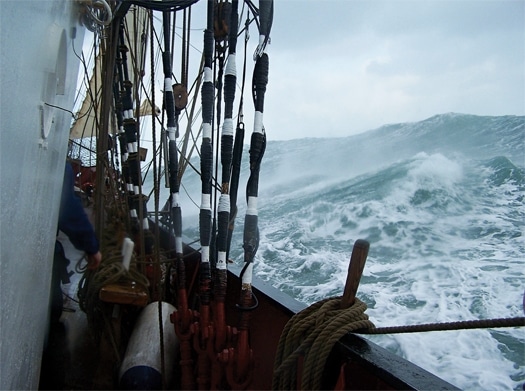
| | |
Overnight, the winds had strengthened to 70 knots with gusts to 90. The pressure system we were in had swung the wind and seas fully to our port beam. Lifelines had been rigged, but it was too dangerous to go out on deck. We would have to ride out this storm with the sail configuration we already had in place-two headsails, two sails on the foremast, and two on the main. By dawn on March 10, the spray from the 30-foot seas and the driving, horizontal rain kept us from even seeing the headrig and the sails on the foremast. The captain had forbidden any travel forward of the helm on the ship’s deck. We knew that lines from the running rig had parted because we could see them trailing alongside the ship, but we had no idea of our sail condition. As a result, for several hours we were unable to run the engine for fear we might draw something into the propeller. The wind continued to strengthen throughout the day, with our anemometer showing gusts over 110 knots. We were now in a Category Two hurricane. The needle on the chart table’s barometer went so far down it left the paper strip. We later learned that the barometric pressure in the Irish Sea as recorded by the Liverpool Bay Coastal Observatory was near 955 millibars-a low that’s only been reached in some of the biggest storms on record.
The worst of this one lasted more than a day. After a while, life seemed to consist solely of wind and rain and the constant, heavy motion of the ship. The dark clouds and black sea were our whole world. When we could finally see the damaged sails on the mainmast, we were powerless to do anything. With the wind as strong as it ever was and the seas continuing to tower over us, we had to rely on the engine. At 300 horsepower, it wasn’t strong enough to provide much propulsion but it did push water past the rudder, and that allowed us to keep the bow pointed northeast, which was the safest heading for us. Our forward progress was negligible and we were essentially hoveto as the storm passed overhead. Instead of a full watch of 10 to 12 people on deck, we had two people on the wheel working very hard to maintain our heading and a mate standing by at the binnacle. Everyone else was belowdeck. Only a few more experienced members of the crew were chosen to man the wheel. We waited, fully dressed out, for our turns. Keeping the helm in this weather was exhausting, so watchstanders were relieved at rapid intervals.
Real sleep was impossible for anyone. The ship was heeled over at a consistent 20 degrees to starboard but rolling beyond 40 degrees. With the water hitting the ship on the port beam, the pitching wasn’t severe. But occasionally we’d slam into the sea as the bow drove down, and if you weren’t holding on tight you’d be thrown hard against an unforgiving bulkhead-it was like hitting a stone wall. Neither the Roald Amundsen nor any of her crew had ever been through a storm like this. During the night, much of the crew sat shoulder-to-shoulder in the mess, so we had someplace to lean as we tried to doze. Most of the off-watch crew sat, since very few people were able to stay in their bunks anyway. As the watchstanders were relieved of the wheel and came below, their shipmates helped them get their wet clothes off and provided hot drinks and soup to warm them up. Because only a few in the watch were selected to work topside, it wasn’t long before our turn at the wheel came again.
Eventually the storm moved south, and began to leave us behind. The wind and sea began to diminish. I was never so happy to see a simply gray sky after more than 24 hours of nothing but black. Blue skies seemed like a long-distant memory. It was still too dangerous to go aloft, but by the dawn’s light we could finally see the extent of the damage. Of the 17 sails on the rig, 11 of them had been utterly shredded by the storm. Six of those had even been furled and lashed to the yards! The ship’s rig had miraculously survived unscathed-a living testament to the Roald’s workmanship. I remember going on watch after the storm, surveying the damage, eyeing the skies, and thinking, “The wind’s blowing at just sixty knots-it’s going to be a nice day.”
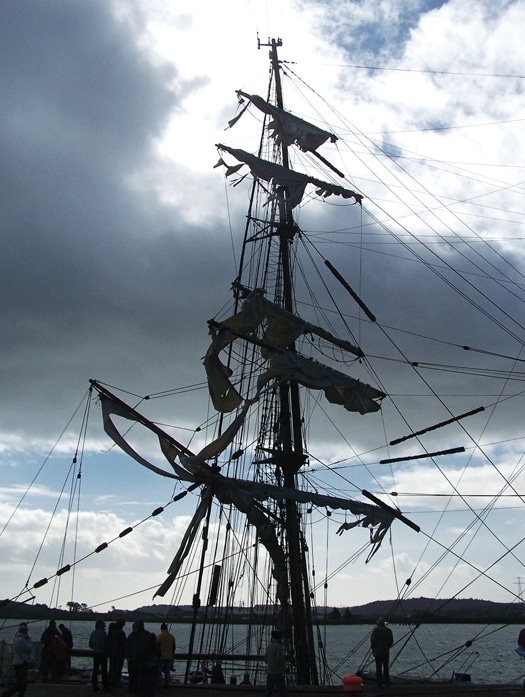
| | |
It was only when we sighted Ireland that the whole crew seemed at last to realize what we had accomplished. We anchored in the harbor overnight because of the rough weather, and the next morning we finally tied up to end our journey. Very shortly after that, many of us walked to the top of a nearby hill to visit St. Colman’s cathedral and say our thanks for having survived a storm that we knew could have killed us.
I’m safe at home now and helping to prepare Niagara for another sailing season on the Great Lakes. I cherish the friendships I’ve made with my shipmates from Roald Amundsen. Though we weren’t fluent in each other’s language, we have an unbreakable bond that transcends mere words-or even numbers: Crew 217 will always be known as the Storm Crew-in any language.
Bob Harkins is a retired U. S. Navy Chief Petty Officer who lives in Erie, Pennsylvania, and the winner of our fiercely competitive North Pole Adventure Contest. Look for more entries in upcoming issues.

